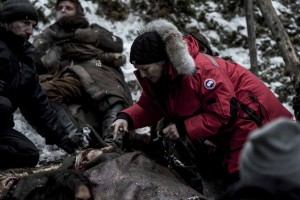
When Grigg got the call to join the crew of The Revenant, she was in the midst of doing two other jobs, but DiCaprio insisted that she undertake Iñárritu’s newest project. “He had talked to us before about the film,” Grigg said of DiCaprio. “I knew there was a lot of prosthetics involved. I read the script straight away—there wasn’t much lead time for all of the work required for him.”
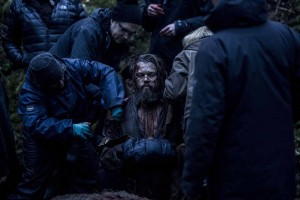 Within two weeks, Grigg flew to Los Angeles to meet with Iñárritu and discuss the massive requirements ahead regarding The Revenant’s makeup challenges. “It was barely green lit, and there were so many questions,” Grigg revealed. “In the first meeting, all that we managed to work out was in the bear attack; it was really unbelievable that he survived. One of his legs had to be dislocated, and one of his hands wasn’t able to be used. Alejandro got on the floor and figured out how he was going to crawl. You have to use the opposite leg—we figured out the left leg would be dislocated. We took the body cast of Leo the next day. We needed to get started straight away. We got the lifecast back in the UK.”
Within two weeks, Grigg flew to Los Angeles to meet with Iñárritu and discuss the massive requirements ahead regarding The Revenant’s makeup challenges. “It was barely green lit, and there were so many questions,” Grigg revealed. “In the first meeting, all that we managed to work out was in the bear attack; it was really unbelievable that he survived. One of his legs had to be dislocated, and one of his hands wasn’t able to be used. Alejandro got on the floor and figured out how he was going to crawl. You have to use the opposite leg—we figured out the left leg would be dislocated. We took the body cast of Leo the next day. We needed to get started straight away. We got the lifecast back in the UK.”
A bulk of The Revenant was shot outside Calgary in Alberta, Canada, but the production ran out of snow before filming wrapped, necessitating that they shoot pickups several months later in Argentina. “We didn’t do anything at all on stage,” she said of Iñárritu’s and cinematographer Emmanuel Lubezki’s insistence on photorealism. “Alejandro and Chivo [Lubezki] want it all to be natural. You usually have the luxury of some black for an edge, but there was no help on this. It was stressful from the point-of-view that you were constantly worried but Alejandro is a genius that you love to work with.”
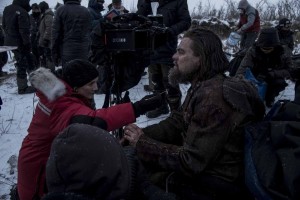 In addition to actuating the makeup effects needed for the bear attack, Grigg and Jarman had to maneuver their work around Iñárritu’s and Lubezki’s system of shooting scenes with a minimum of camera cuts. “It was quite a tall order—he likes to use as few cuts as possible,” Grigg conveyed of her director. “We made the pieces, and did a provisional test to show Alejandro [the makeup] all painted and colored. We did a couple of tests to work out the blood flow and what color blood we would use. He wanted the neck [wounds] to be much more severe. He wanted the face to have more physical injury; bolder on his face—a huge slash right through his hair.”
In addition to actuating the makeup effects needed for the bear attack, Grigg and Jarman had to maneuver their work around Iñárritu’s and Lubezki’s system of shooting scenes with a minimum of camera cuts. “It was quite a tall order—he likes to use as few cuts as possible,” Grigg conveyed of her director. “We made the pieces, and did a provisional test to show Alejandro [the makeup] all painted and colored. We did a couple of tests to work out the blood flow and what color blood we would use. He wanted the neck [wounds] to be much more severe. He wanted the face to have more physical injury; bolder on his face—a huge slash right through his hair.”
To create the effect, Grigg required a silicone appliance with hair laid over the top to hide the effect. “It was very effective, but the way Alejandro shoots, a lot of your work doesn’t get shown,” she stated. “Every bit, you don’t have the luxury of closeups to reveal what you want.”
Nevertheless, Grigg admitted that Iñárritu’s process mandates “a necessary sacrifice. You feel like you are actually there in person watching the film on the screen. It heartbreaking, but it’s for the greater good. The shot evolves, so you have to be able to allow that to happen. Given the quiet patches, the suspense is unbelievable.”
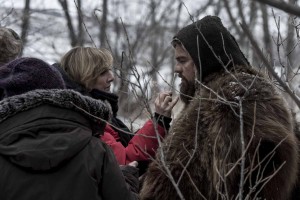 One prominent wound unveiled after the bear attack was across DiCaprio’s chest. “He had a full chest piece that we worked out when we did the test,” Grigg noted. “The alcohol in the blood takes off the paint—we had to work out a different way to do that. We had to have it as durable as it could possibly be.”
One prominent wound unveiled after the bear attack was across DiCaprio’s chest. “He had a full chest piece that we worked out when we did the test,” Grigg noted. “The alcohol in the blood takes off the paint—we had to work out a different way to do that. We had to have it as durable as it could possibly be.”
With pre-colored appliances featuring hair punched into them, Grigg and Jarman implemented prosthetics for DiCaprio’s chest, back, side, lower left arm, and pieces on his left hand. In addition, he featured a neck gash and several pieces on his face into his hairline with inlaid lace hair pieces. Every injury on his chest and back would also eventually allow for a stitched version.
In addition to the appliances, Grigg and Jarman had to actuate spurting blood on DiCaprio’s back of the neck with two different colors of blood. “Our hero blood and separate blood in the neck,” Grigg explained. “It was freezing cold. I had to really worry about safety of my actor: when he was crawling in that snow, we had prosthetics on his hands. We had a hot hair dryer to warm up his hands.‘Are my prosthetics falling off?’ [DiCaprio wondered aloud]. His hands were so cold.”
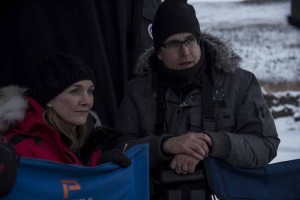 On top of the bear injury makeups and effects, DiCaprio had to adopt a frontiersman’s appearance. “Every makeup was incredibly long,” Grigg confessed. “Alejandro wanted him to look like a real woodsman. He wanted him to look weathered – lots of layering of colors, aging on him, scars; [we] grayed his beard by doing individual hairs which took 20 minutes every day.”
On top of the bear injury makeups and effects, DiCaprio had to adopt a frontiersman’s appearance. “Every makeup was incredibly long,” Grigg confessed. “Alejandro wanted him to look like a real woodsman. He wanted him to look weathered – lots of layering of colors, aging on him, scars; [we] grayed his beard by doing individual hairs which took 20 minutes every day.”
Purposefully, Grigg and Jarman utilized a full team of prosthetic artists in England to fabricate all the appliances, including teeth. “Chris Lyons did an amazing job on the teeth,” Grigg noted. “I had to take it to Calgary to make it work—change the shape of his mouth a little bit to look more rugged and a little less handsome, to make him look like he had a tough life. It’s a different look for people who have lived like that. Weathered wrinkling in reds, and browns, and putting the dirt on top.”
Veteran hairstylist Kathryn Blondell supervised DiCaprio’s evolving hair styling work on the film. “He always had to have dirty hair,” remarked Grigg. “They aren’t having a shower; maybe they would wash in the river. On the longest days, [DiCaprio’s full makeup and hairstyling] was 4 ½-5 hours. We built in breaks for Leo; we brought in documentaries to listen to to get through the length of time he had to be there: props, makeups and costume working together.”
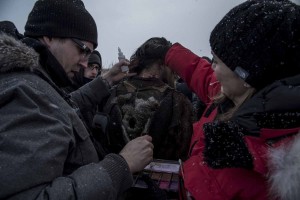 Though Grigg and Jarman did not have to apply full facial trauma every day of the shoot, they were required to also convincingly prepare DiCaprio’s photo doubles and stunt doubles. “Duncan would work with me on those days,” said Grigg. “It was 1 ½ to 2 hours to do [DiCaprio’s] face. There were quite a lot of points in the script where his makeup was story-driven. You would see the progression in the wounds, so you would see the infection setting in—and gangrene.”
Though Grigg and Jarman did not have to apply full facial trauma every day of the shoot, they were required to also convincingly prepare DiCaprio’s photo doubles and stunt doubles. “Duncan would work with me on those days,” said Grigg. “It was 1 ½ to 2 hours to do [DiCaprio’s] face. There were quite a lot of points in the script where his makeup was story-driven. You would see the progression in the wounds, so you would see the infection setting in—and gangrene.”
Additionally, Grigg and Jarman did not have the advantage of holding their most detailed work for DiCaprio’s closeups, typically shot towards the end of a scene. “You go from a massive vista to an extreme closeup in the same shot,” she said of Inarritu’s modus operandi. “You can’t cheat those. We were always quite a ways away looking in the monitor because of the logistics of the wilderness. It could have been much worse—any film like that is going to be a challenge.”
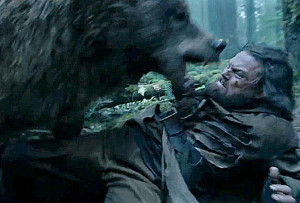 Dirtying up DiCaprio might sound like a simple task, but Grigg took careful steps to make the dirt on her lead actor look realistic. “I used makeup made in the UK to put the dirt on the hands,” she related. “On his neck, I used dirt powder to absorb into his skin and give you the nice crease in the neck; it’s ingrained, not patchy. On the face, I used K-Y jelly and dirt powder that I could control better – you don’t want to look at a shiny face all of the time.”
Dirtying up DiCaprio might sound like a simple task, but Grigg took careful steps to make the dirt on her lead actor look realistic. “I used makeup made in the UK to put the dirt on the hands,” she related. “On his neck, I used dirt powder to absorb into his skin and give you the nice crease in the neck; it’s ingrained, not patchy. On the face, I used K-Y jelly and dirt powder that I could control better – you don’t want to look at a shiny face all of the time.”
Looking back, normally, when she starts a film, Grigg likes to have all of her stages of makeup carefully devised and tested, but The Revenant was an exception. “Before starting shooting, the only [stage] we really had down was the bear attack,” she said. “We tested that in Calgary—everyone was really happy with it. We had to play catch up with all of the other stages. If ever Leo had the day off, Duncan and I would be in the trailer doing tests with the doubles. There were seven stages just on his neck. We had to test while we were still shooting.”
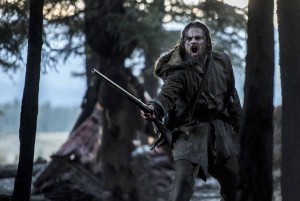 Regardless of her lack of preparatory time, Grigg had high praise for Iñárritu. “Alejandro loves makeup and cares about every aspect of the film,” she revealed. “I found him really inspiring. He would push me and gave me the courage to push it even further. He suggested I watch a documentary about these climbers and what they went through. I really, really wanted to push it; I got Duncan to create new pieces—he went back and sculpted it even more. That’s exactly what I want! He made the smaller pieces and facial pieces in the trailer. The bigger pieces, we had made in the UK. Normally, we work with quite a small unit, Duncan and I. In the end, we had to get Kristyan Mallett help with the manufacturing of all the pieces.”
Regardless of her lack of preparatory time, Grigg had high praise for Iñárritu. “Alejandro loves makeup and cares about every aspect of the film,” she revealed. “I found him really inspiring. He would push me and gave me the courage to push it even further. He suggested I watch a documentary about these climbers and what they went through. I really, really wanted to push it; I got Duncan to create new pieces—he went back and sculpted it even more. That’s exactly what I want! He made the smaller pieces and facial pieces in the trailer. The bigger pieces, we had made in the UK. Normally, we work with quite a small unit, Duncan and I. In the end, we had to get Kristyan Mallett help with the manufacturing of all the pieces.”
In Iñárritu, Grigg ultimately had a filmmaking collaborator who took care to integrate the makeup into his broad canvas used to tell the story. “It’s very rewarding when somebody takes such an interest in makeup, but he’s like that with every aspect,” said Grigg. “When you get it right, it’s very rewarding. Because of the nature of the way Alejandro shoots, if you don’t get it, you have to get it the next day. You have to be prepared for everything. As a result, the scale of our operation got bigger than we are used to. He wanted everything to look real. It was a joy for me; he really appreciated the detail and reality and the work. It was a massive job with a whole team of people. With Alejandro and Chivo, as long as you have photos to show them, they love it. ‘Go for it!’”





